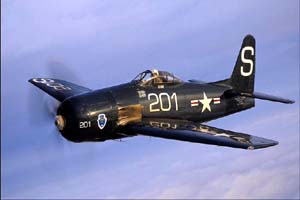Grumman F8F-2 Bearcat
US Navy Fighter
 |
The Ghost Squadron's F8F-2 Bearcat. Image source: The Confederate Air Force Ghost Squadron CD-ROM produced by Corel. Photos by Bill Crump. |
By the last half of the Second World War, most new US fighter designs were much heavier and more complex than earlier fighters. When planning a replacement for their successful F6F Hellcat carrier fighter, however, Grumman chose to built as lightweight a design as possible around the most reliable large radial engine. The result was the F8F Bearcat, which was often called a "hot rod" by its pilots for its fantastic acceleration and climbing ability.
Using the well-proven Pratt & Whitney R-2800 engine, the first Bearcat prototype flew on August 21, 1944. After minor modifications, including the addition of a dorsal fin, early production F8F-1s began armament tests and carrier qualification trials in early 1945. By May of 1945, the Bearcat was cleared for operations, with very few restrictions on its flight operations over its wide speed range. A total of 654 F8F-1s were delivered, all fitted with the 2,100 hp R-2800-34W engine.
The Bearcat was the first US Navy fighter to feature a full "bubble" canopy, giving excellent all around vision. It was also fitted with so called "Safety Wing Tips", the outer 40 inches of which were designed to break off cleanly in case of the wing being overstressed in a dive or other maneuver. After several incidents where one or both wing tips tore off, this feature was eliminated from later production Bearcats.
Two squadrons, VF-18 and VF-19 were equipped with F8F-1s, and training was expedited in order to get the new fighter into service against Japanese suicide attack planes in the Pacific. VF-19 was onboard the carrier USS Langley, enroute across the Pacific, when the war ended on August 16, 1945.
The final production Bearcat was the F8F-2, with a more powerful R-2800-30W engine of 2,250 hp and an automatic variable speed supercharger. The extra power required an extra foot be added to the vertical fin, and F8F-2s carried a heavier armament of four 20mm cannons. The F8F-2P was a photo-reconnaissance version, fitted with up to three cameras in the fuselage. By 1956, the last Bearcats were taken out of service and stored or scrapped, having been replaced by the new age of jets.
Specifications
One Pilot One Pratt & Whitney R-2800-30W Engine Four 20mm Cannons Max. Speed 455 mph @ 28,000 feet Initial Rate of Climb 6,300 ft/min |
Length 27' 6" Max. Weight 13,460 lbs Normal Fuel 185 gallons Normal Range 865 miles |